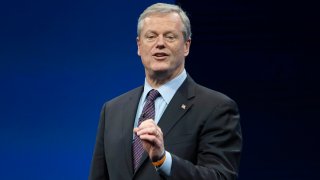
Donor-fueled collectives that raise money and funnel it to college athletes through name, image and likeness opportunities they facilitate probably won't go away entirely if NCAA President Charlie Baker's proposals for paying athletes become reality. But changes will be inevitable.
Baker has recommended that Division I schools be allowed to enter into licensing deals directly with their athletes, essentially paying them to be school ambassadors. He suggested that the wealthiest schools be required to pay half of their athletes at least $30,000 per year. For a school like Texas, with some 700 athletes, that would be a sum of some $10 million.
Collectives, technically operating independently from the schools they serve, have sprung up across the country since the NCAA began allowing athletes to make money off their celebrity two years ago. The collectives — some 200 of them — seek donations from boosters, alumni and fans and then arrange opportunities for athletes to be paid for endorsements, public appearances, autograph-signing and posting branded content to their personal social media channels.
Experts said the collectives could be absorbed into athletic departments to provide some of the same services they do now or they could continue operating independently.
Get top local stories in Southern California delivered to you every morning. Sign up for NBC LA's News Headlines newsletter.
Jason Belzer, founder of Student Athlete NIL, which operates several commercial collectives for schools across the country, said fund-raising by outside collectives would be unnecessary if athlete-targeted donations were allowed to be made directly to the school.
Corey Staniscia, director of the Fowler Ave Collective that backs USF athletics, said he would “welcome the day” when NIL work can be done through schools themselves.
“Allow the institutions to contract with athletes even just for their rights of publicity to directly sell merch, co branded billboards and bobble heads for fans,” Staniscia posted on X. “That really isn’t moving mountains here. It’s not too difficult.”
NCAAF
Opendorse CEO Blake Lawrence, whose company partners with schools to help initiate, track and monitor NIL deals, said there will be a place for collectives in the environment proposed by Baker.
“Third-party compensation for NIL activities that are not controlled by the institution will exist,” Lawrence said. “It will be very hard to remove that element. I think there may be less pressure on the collectives in terms of how much they’re tasked with sourcing for athletes and their third-party payments. But they do not go away.”
Athletes.org co-founder Jim Cavale, whose organization seeks to give athletes a voice in plotting the future of college sports and an NIL pioneer as developer of the platform INFLCR, said collectives could be folded into the athletic departments not so much for fund-raising but instead to activate and service NIL deals.
NIL activity directly tied to schools could raise issues of liability and almost certainly would bring Title IX implications. Under the current setup, with NIL collectives operating outside the schools they support, the federal civil rights law prohibiting sex-based discrimination by schools receiving federal funds theoretically does not apply.
Thomas Thomas Jr,, co-founder and CEO at NIL software company Basepath, said Baker’s proposal “could be a big win for female athletes.”
Kassandra Ramsey, a Washington-based sports attorney who specializes in NIL issues, said if a school has “significant involvement” with NIL, it would have a responsibility to ensure there are equitable opportunities for men and women. However, she said, that doesn't mean male and female athletes have to make the same amount of money.
“I think the opportunity to make the money and get the NIL deals is what have to be the same,” she said.
Lawrence said equal NIL pay for men and women, let alone for players on the same team, would be nearly impossible.
“The NIL value of an athlete is so individualized, it’s really hard to understand how a school could pay an athlete their true NIL value while ensuring Title IX compliance,” Lawrence said. “It would be happenstance if you could really have a perfect balance between men’s and women’s sports NIL value.”



